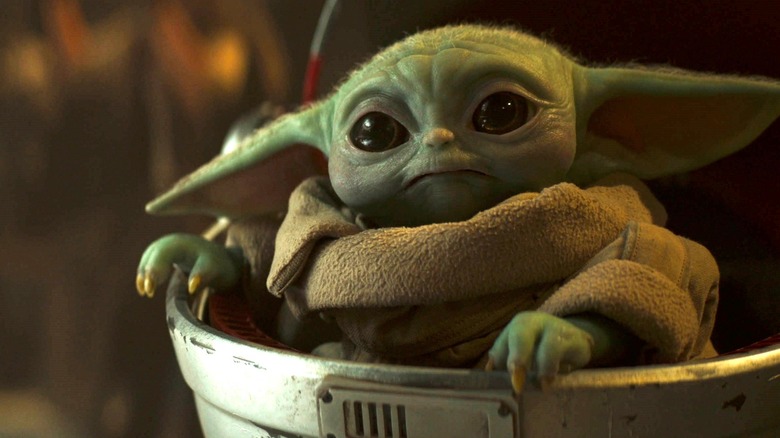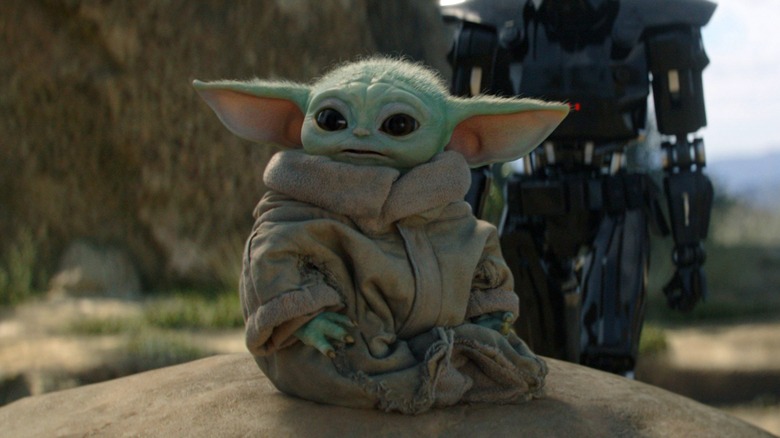The Mandalorian: Why Grogu's Face Was Almost Radically Different
A delightful surprise had "Star Wars" fans buzzing at the end of the premiere episode of the smash series "The Mandalorian" in November 2019 when it was revealed that the prize bounty Din Djarin (Pedro Pascal) was pursuing was a tiny green creature with a familiar-looking set of ears. Initially dubbed "Baby Yoda" by fans because of his youthful resemblance to the famed Jedi master, "The Child," as he was first referred to in the series, was properly identified by Ahsoka Tano (Rosario Dawson) in Season 2 as "Grogu."
It's hard to imagine Grogu looking different, especially given the plethora of merchandise that has been released featuring the innocent visage of the instant pop culture icon. However, the visual effects team behind "The Mandalorian" told Metacritic that they first considered making Grogu a CGI creation for closeup shots of the creature. Even more fascinating, the effects wizards recalled that series creator Jon Favreau was considered to provide Grogu's facial expressions via motion capture, which could have radically affected his ultimate appearance.
Those ideas fell by the wayside, of course, with the creation of the sophisticated puppet loaded with all sorts of wires, rods, and gears to make Grogu appear as lifelike as possible. The rationale, Legacy Effects supervisor John Rosengrant explained, was to have a physical character that "The Mandalorian" actors could interact with. Recalling his mindset for Metacritic, Rosengrant said, "If we could have that little child be there and be real and have actors really looking at it, just maybe we can make this thing work."
Grogu was treated like a real baby
The technology behind Grogu seems eons ahead of his "Star Wars" predecessor, Yoda, who made his debut in "Star Wars: Episode VI – The Empire Strikes Back." Yoda's backstory, from a technical standpoint, at least, is a more humble one, as he merely came to life through puppeteers and was voiced by legendary "Muppets" performer Frank Oz. On the other hand, Grogu is a technical marvel that appeared to be a living, breathing creature once it was fully constructed.
John Rosengrant told Metacritic that the hardwired puppet seemed so real to "Mandalorian" cast member Werner Herzog — who is simply billed as "The Client," the character who put the bounty out on Grogu — that he was worried when the puppet was shut off. "He thought it was very real, and it added a lot to his performance," Rosengrant said. Grogu apparently felt real to "Star Wars" creator George Lucas as well. Lucas held the puppet like he was cradling an actual infant, Industrial Light and Magic Senior Vice President Janet Lewin recalled. "You can't resist cradling the baby, bouncing the baby ... It's a puppet," Lewin told Metacritic.
For those who may feel Jon Favreau missed a big opportunity by not doing the facial motion capture for Grogu, he did get another opportunity to act in the "Star Wars" series. Favreau — whose acting credits include Happy Hogan in the Marvel Cinematic Universe – provides the voice for the Heavy Infantry Mandalorian Paz Vizsla in "The Mandalorian" as well as an episode of "The Book of Boba Fett," while actor Tait Fletcher physically wears the armor.

